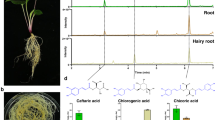Abstract
A hydrophobic cuticle consisting of waxes and the polyester cutin covers the aerial epidermis of all land plants, providing essential protection from desiccation and other stresses. We have determined the enzymatic basis of cutin polymerization through characterization of a tomato extracellular acyltransferase, CD1, and its substrate, 2-mono(10,16-dihydroxyhexadecanoyl)glycerol. CD1 has in vitro polyester synthesis activity and is required for cutin accumulation in vivo, indicating that it is a cutin synthase.
This is a preview of subscription content, access via your institution
Access options
Subscribe to this journal
Receive 12 print issues and online access
$259.00 per year
only $21.58 per issue
Buy this article
- Purchase on Springer Link
- Instant access to full article PDF
Prices may be subject to local taxes which are calculated during checkout



Similar content being viewed by others
Accession codes
References
Edwards, D. New Phytol. 125, 225–247 (1993).
Nawrath, C. Curr. Opin. Plant Biol. 9, 281–287 (2006).
Heredia, A. et al. Biointerphases 4, P1–P3 (2009).
Pollard, M., Beisson, F., Li, Y. & Ohlrogge, J.B. Trends Plant Sci. 13, 236–246 (2008).
Isaacson, T. et al. Plant J. 60, 363–377 (2009).
Akoh, C.C., Lee, G.C., Liaw, Y.C., Huang, T.H. & Shaw, J.F. Prog. Lipid Res. 43, 534–552 (2004).
Volokita, M., Rosilio-Brami, T., Rivkin, N. & Zik, M. Mol. Biol. Evol. 28, 551–565 (2011).
Irshad, M., Canut, H., Borderies, G., Pont-Lezica, R. & Jamet, E. BMC Plant Biol. 8, 94 (2008).
Matas, A.J. et al. Plant Cell 23, 3893–3910 (2011).
Mintz-Oron, S. et al. Plant Physiol. 147, 823–851 (2008).
Reina, J.J., Guerrero, C. & Heredia, A. J. Exp. Bot. 58, 2717–2731 (2007).
Yeats, T.H. et al. J. Exp. Bot. 61, 3759–3771 (2010).
Baker, E.A., Bukovac, M.J. & Hunt, G.M. in The Plant Cuticle (eds. Cutler, D.F., Alvin, K.L. & Price, C.E.) 33–44 (Academic Press, London, 1982).
Yang, W. et al. Proc. Natl. Acad. Sci. USA 107, 12040–12045 (2010).
Graça, J., Schreiber, L., Rodrigues, J. & Pereira, H. Phytochemistry 61, 205–215 (2002).
Jetter, R., Kunst, L. & Samuels, A.L. in Biology of the Plant Cuticle (eds. Riederer, M. & Müller, C.) 145–181 (Blackwell, Oxford, 2006).
Li, Y., Beisson, F., Ohlrogge, J. & Pollard, M. Plant Physiol. 144, 1267–1277 (2007).
Graça, J. & Lamosa, P. J. Agric. Food Chem. 58, 9666–9674 (2010).
Osman, S.F., Irwin, P., Fett, W.F., O'Connor, J.V. & Parris, N. J. Agric. Food Chem. 47, 799–802 (1999).
Jonas, A. Biochim. Biophys. Acta 1529, 245–256 (2000).
Croteau, R. & Kolattukudy, P.E. Biochemistry 13, 3193–3202 (1974).
Panikashvili, D., Shi, J.X., Schreiber, L. & Aharoni, A. Plant Physiol. 151, 1773–1789 (2009).
Shi, J.X. et al. PLoS Genet. 7, e1001388 (2011).
Acknowledgements
We thank G. Lomonossoff (John Innes Centre) and Plant Bioscience Limited for the pEAQ vector, M. Toso for help with transmission electron microscopy, S. Zhang and B. Sherwood for assistance with MALDI-TOF MS and M. Pollard and K. Niklas for critical discussion. This work was supported by grants from the US National Science Foundation (Plant Genome Program; DBI-0606595), the United States–Israel Binational Agricultural Research and Development Fund (IS-4234-09); the US Department of Agriculture Cooperative State Research, Education and Extension Service (2011-04197); and the Danish Council for Strategic Research (10-093465). T.H.Y. was supported in part by a US National Institutes of Health Chemistry-Biology Interface Training Grant (T32 GM008500).
Author information
Authors and Affiliations
Contributions
T.H.Y. purified recombinant protein and performed chemical analysis of soluble surface lipids and acyltransferase assays. L.B.B.M. performed gene and protein expression experiments and cutin analysis. H.M.-F.V. and M.H.C. synthesized 2-MHG. T.I. identified and performed initial characterization and rough mapping of the mutant. Y.H. and L.Z. performed fine genetic mapping experiments and constructed the transgenic complementation vector. A.J.M. performed the tissue-specific gene expression experiments. G.J.B. conducted light microscopy experiments. L.B.B.M. and D.S.D. performed immunolocalization experiments. T.H.Y., L.B.B.M. and J.K.C.R. designed the study, analyzed the data and wrote the paper.
Corresponding author
Ethics declarations
Competing interests
The authors declare no competing financial interests.
Supplementary information
Supplementary Text and Figures
Supplementary Methods and Supplementary Results (PDF 1555 kb)
Rights and permissions
About this article
Cite this article
Yeats, T., Martin, L., Viart, HF. et al. The identification of cutin synthase: formation of the plant polyester cutin. Nat Chem Biol 8, 609–611 (2012). https://doi.org/10.1038/nchembio.960
Received:
Accepted:
Published:
Issue Date:
DOI: https://doi.org/10.1038/nchembio.960
This article is cited by
-
Fine mapping and candidate gene analysis of CaFCD1 affecting cuticle biosynthesis in Capsicum annuum L.
Theoretical and Applied Genetics (2023)
-
The SlSHN2 transcription factor contributes to cuticle formation and epidermal patterning in tomato fruit
Molecular Horticulture (2022)
-
Genome-wide association study and genetic mapping of BhWAX conferring mature fruit cuticular wax in wax gourd
BMC Plant Biology (2022)
-
Constitutive expression of a pea apyrase, psNTP9, increases seed yield in field-grown soybean
Scientific Reports (2022)
-
Differential regulation of triterpene biosynthesis induced by an early failure in cuticle formation in apple
Horticulture Research (2021)



